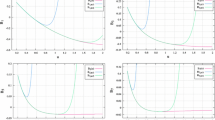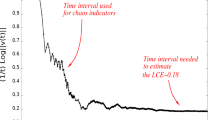Abstract
A number of studies, referring to the observed Trojan asteroids of various planets in our Solar System, or to hypothetical Trojan bodies in extrasolar planetary systems, have emphasized the importance of so-called secondary resonances in the problem of the long term stability of Trojan motions. Such resonances describe commensurabilities between the fast, synodic, and secular frequency of the Trojan body, and, possibly, additional slow frequencies produced by more than one perturbing bodies. The presence of secondary resonances sculpts the dynamical structure of the phase space. Hence, identifying their location is a relevant task for theoretical studies. In the present paper we combine the methods introduced in two recent papers (Páez and Efthymiopoulos in Celest Mech Dyn Astron 121(2):139, 2015; Páez and Locatelli in MNRAS 453(2):2177, 2015) in order to analytically predict the location of secondary resonances in the Trojan problem. In Páez and Efthymiopoulos (2015), the motion of a Trojan body was studied in the context of the planar Elliptic Restricted Three Body or the planar Restricted Multi-Planet Problem. It was shown that the Hamiltonian admits a generic decomposition \(H=H_b+H_{sec}\). The term \(H_b\), called the basic Hamiltonian, is a model of two degrees of freedom characterizing the short-period and synodic motions of a Trojan body. Also, it yields a constant ‘proper eccentricity’ allowing to define a third secular frequency connected to the body’s perihelion precession. \(H_{sec}\) contains all remaining secular perturbations due to the primary or to additional perturbing bodies. Here, we first investigate up to what extent the decomposition \(H=H_b+H_{sec}\) provides a meaningful model. To this end, we produce numerical examples of surfaces of section under \(H_b\) and compare with those of the full model. We also discuss how secular perturbations alter the dynamics under \(H_b\). Secondly, we explore the normal form approach introduced in Páez and Locatelli (2015) in order to find an ‘averaged over the fast angle’ model derived from \(H_b\), circumventing the problem of the series’ limited convergence due to the collision singularity at the 1:1 MMR. Finally, using this averaged model, we compute semi-analytically the position of the most important secondary resonances and compare the results with those found by numerical stability maps in specific examples. We find a very good agreement between semi-analytical and numerical results in a domain whose border coincides with the transition to large-scale chaotic Trojan motions.










Similar content being viewed by others
Notes
We stress here that after each transformation we do not change the name of the canonical variables in order to simplify the notation.
References
Alexandersen, M., Gladman, B., Greenstreet, S., Kavelaars, J.J., Petit, J.-M., Gwyn, S.: A Uranian Trojan and the frequency of temporary giant-planet co-orbitals. Science 341(6149), 994 (2013)
Beaugé, C., Roig, F.: A semianalytical model for the motion of the Trojan asteroids: proper elements and families. Icarus 153, 391 (2001)
Beaugé, C., Sándor, Z., Érdi, B., Süli, A.: Co-orbital terrestrial planets in exoplanetary systems: a formation scenario. Astron. Astrophys. 463, 359 (2007)
Bowell, E., Holt, H.E., Levy, D.H., Innanen, K.A., Mikkola, S., Shoemaker, E.M.: 1990 MB: the first Mars Trojan. Bull. Astron. Soc. 22(4), 1357 (1990)
Connors, M., Wiegert, P., Veillet, C.: Earth’s Trojan asteroid. Nature 475, 481 (2011)
Cresswell, P., Nelson, R.P.: On the growth and stability of Trojan planets. Astron. Astrophys. 493, 1141 (2009)
Dobrovolskis, A.: Effects of Trojan exoplanets on the reflex motions of their parent stars. Icarus 226, 1635 (2013)
Efthymiopoulos, C.: On the connection between the Nekhoroshev theorem and Arnold diffusion. Celest. Mech. Dyn. Astron. 102, 49 (2008)
Efthymiopoulos, C., Harsoula, M.: The speed of Arnold diffusion. Phys. D 251, 19 (2013)
Érdi, B.: The three-dimensional motion of Trojan asteroids. Celest. Mech. 18, 141 (1978)
Érdi, B.: Long periodic perturbations of Trojan asteroids. Celest. Mech. 43, 303 (1988)
Érdi, B.: The Trojan problem. Celest. Mech. Dyn. Astron. 65, 149 (1997)
Érdi, B., Nagy, I., Sándor, Z., Süli, A., Fröhlich, G.: Secondary resonances of co-orbital motions. MNRAS 381, 33 (2007)
Froeschlé, C., Lega, E., Gonczi, R.: Fast Lyapunov indicators. Application to asteroidal motion. Celest. Mech. Dyn. Astron. 67, 41 (1997)
Haghighipour, N., Capen, S., Hinse, T.: Detection of Earth-mass and super-Earth Trojan planets using transit timing variation method. Celest. Mech. Dyn. Astron. 117, 75 (2013)
Laskar, J.: Frequency map analysis and quasiperiodic decompositions. In: Benest, D., Froeschlé, C., Lega, E. (eds.) Hamiltonian Systems and Fourier Analysis. Cambridge Scientific, Cambridge (2004)
Milani, A.: The Trojan asteroid belt: proper elements, stability, chaos and families. Celest. Mech. Dyn. Astron. 57, 59 (1993)
Morbidelli, A.: Aspects of Solar System Dynamics. Taylor & Francis Scientific Publishers, Cambridge (2011)
Murray, C.D., Dermott, S.F.: Solar Systems Dynamics. Cambridge Universiy Press, Cambridge (1999)
Namouni, F., Murray, C.D.: The effect of eccentricity and inclination on the motion near the Lagrangian points \(L_4\) and \(L_5\). Cel. Mech. Dyn. Astron. 76, 131 (2000)
Páez, R.I., Efthymiopoulos, C.: Trojan resonant dynamics, stability, and chaotic diffusion, for parameters relevant to exoplanetary systems. Celest. Mech. Dyn. Astron. 121(2), 139 (2015)
Páez, R.I., Locatelli, U.: Trojan dynamics well approximated by a new Hamiltonian normal form. MNRAS 453(2), 2177 (2015)
Rabe, E.: Stability characteristics of the short-period Trojan librations. Astron J. 73, 732 (1968)
Robutel, P., Bodossian, J.: The resonant structure of Jupiter’s Trojan asteroids - II. What happens for different configurations of the planetary system. MNRAS 399, 69 (2009)
Robutel, P., Souchay, J.: An introduction to the dynamics of Trojan asteroids. Lect. Notes Phys. 790, 195 (2010)
Acknowledgments
The author would like to thank the anonymous referees for their remarks, that helped improving the quality of the present text. During this work, R.I.P. was supported by the Astronet-II Marie Curie Training Network (PITN-GA-2011-289240) and by the project “Dynamics of the celestial bodies in the neighborhood of the Lagrangian points” of the University of Rome “Tor Vergata”.
Author information
Authors and Affiliations
Corresponding author
Appendix
Appendix
Variables corresponding to the three degrees of freedom appearing in the expression of the Basic Hamiltonian \(H_b\) in Eq. (5), (u, v), \((Y_f,\phi _f)\) and \((Y_p,\phi _p)\), in terms of the orbital elements:
where \(\lambda \), \(\omega \), a and e are the mean longitude, the longitude of the perihelion, the major semiaxis and eccentricity of the Trojan body, \(\lambda '\) and \(\phi ' = \omega '\) are the mean longitude and longitude of the perihelion of the perturber, \(\beta _0 = \pi /3\), \(y_0 = \sqrt{1-e'^2} -1\), and E represents the total energy of the Trojan as computed from Eq. (4) (see Páez and Efthymiopoulos 2015 for further details in the construction).
Rights and permissions
About this article
Cite this article
Páez, R.I., Locatelli, U. & Efthymiopoulos, C. New Hamiltonian expansions adapted to the Trojan problem. Celest Mech Dyn Astr 126, 519–541 (2016). https://doi.org/10.1007/s10569-016-9710-3
Received:
Revised:
Accepted:
Published:
Issue Date:
DOI: https://doi.org/10.1007/s10569-016-9710-3




